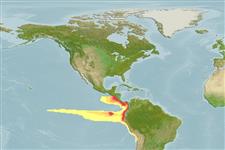Environment: milieu / climate zone / depth range / distribution range
Écologie
marin; profondeur 0 - ? m. Tropical; 13°N -
Eastern Pacific: El Salvador to Peru.
Taille / Poids / Âge
Maturity: Lm ? range ? - ? cm
Max length : 38.0 cm SL mâle / non sexé; (Ref. 9279); common length : 33.0 cm SL mâle / non sexé; (Ref. 9279)
Description synthétique
Clés d'identification | Morphologie | Morphométrie
Épines dorsales (Total) : 0; Rayons mous dorsaux (Total) : 12 - 15; Épines anales: 0; Rayons mous anaux: 14 - 18; Vertèbres: 61 - 66. Caudal fin emarginate (Ref. 9279).
Common in coastal waters and lagoons with mangroves (Ref. 9279). Also found near the surface of offshore waters (Ref. 11035). Feeds mainly on small fishes (Ref. 9279). Oviparous (Ref. 205). Eggs may be found attached to objects in the water by tendrils on the egg's surface (Ref. 205). Usually caught with the help of artificial lights (Ref. 9279).
Life cycle and mating behavior
Maturities | Reproduction | Spawnings | Egg(s) | Fecundities | Larves
Collette, B.B., 1995. Belonidae. Agujones, maraos. p. 919-926. In W. Fischer, F. Krupp, W. Schneider, C. Sommer, K.E. Carpenter and V. Niem (eds.) Guia FAO para Identification de Especies para lo Fines de la Pesca. Pacifico Centro-Oriental. 3 Vols. FAO, Rome. (Ref. 9279)
Statut dans la liste rouge de l'IUCN (Ref. 130435)
Menace pour l'homme
Harmless
Utilisations par l'homme
Pêcheries: intérêt commercial mineur
Outils
Articles particuliers
Télécharger en XML
Sources Internet
Estimates based on models
Phylogenetic diversity index (Ref.
82804): PD
50 = 0.5001 [Uniqueness, from 0.5 = low to 2.0 = high].
Bayesian length-weight: a=0.00126 (0.00055 - 0.00288), b=3.10 (2.92 - 3.28), in cm total length, based on LWR estimates for this Genus-body shape (Ref.
93245).
Niveau trophique (Ref.
69278): 4.2 ±0.73 se; based on food items.
Résilience (Ref.
120179): Haut, temps minimum de doublement de population inférieur à 15 mois (Preliminary K or Fecundity.).
Fishing Vulnerability (Ref.
59153): Moderate vulnerability (36 of 100).
